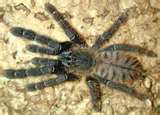Description
Known as the Skeleton Tarantula, due to its white stripes this is a rather strange species that carries urticating hairs on its pedipalps. They can in some cases build very extravagant burrows but seem to prefer floor webbing. As adults, the male Skeleton Tarantula can reach leg spans of around 4.5 inches. Some specimens, usually females, can reach up to 6 inches. Temperament
The Skeleton tarantula is distinctly more aggressive than other species in the Ephebopus genus, and will rear up on their hind legs when disturbed/threatened. If sufficiently offended the spider will flick urticating hairs, usually from it's pedipalps. Housing
Temperature
The optimum temperature for the enclosure is between 22-26°C (71.6-78.8°F). A temperature gradient is important to allow the tarantula to regulate their body temperature as needed. The easiest way to provide the gradient is by using a heating mat designed for use under reptile tanks. This should be placed under no more than about 1/3 of the tank, so your pet can move from warmer to cooler temperatures if desired. Always verify that appropriate temperatures are being provided by using accurate thermometers in a few locations within the enclosure. Humidity
Humidity should be maintained at between 75-85% by providing a large, shallow water bowl, moistening the substrate twice a week and by misting the enclosure regularly. To successfully maintain the desired humidityhygrometer. A hygrometer is a device used to measure relative humidity within the enclosure. conditions for your tarantula you are going to need a
Feeding
They will tackle most insects, including crickets, locusts, roaches and many other livefoods available in your local pet shop. Adults should be fed 4-5 crickets or similar prey items per week. Be sure to remove any uneaten dead food from the enclosure in a timely manner to avoid attracting mites and encouraging bacterial growth. Breeding
Introduce the mature male into the mature female's enclosure. It may take some time for them to start, but If they are ready or interested to mate, the male will eventually drum or tap his legs around the females burrow, any webbing, or substrate. Again it may take time for the female to respond, but she in turn will drum her legs, you'll hear it. They will then try and find each other. Once they make contact, the male will use his tibial hooks on the front 2 legs to hook the females fang's. At this point he bends her back and attempts to insert the pedipalps into the female. Once they break contact the female is amazingly docile and usually retreats back to her burrow leaving the male to escape. During courtship and breeding they are known to co-habilitate in the female's burrow for several days. Sexual Cannibalism may occur unless the male is provided with a means of escape from the female's burrow, it is recommended that you leave the lid off the female's enclosure and place it in a larger confined tank/rubbermaid. If the male makes it out of the burrow he will have somewhere to run to where the female cannot chase him.




